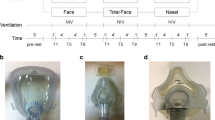Abstract
Noninvasive ventilation uses masks for management of respiratory failure. Its challenges are (1) minimizing leakage around the mask with a tight fit, preventing an increase in the ventilator’s tidal volume; (2) using a comfortable interface that does not cause side effects; and (3) providing compensation for leakage with increased volume or pressure. The aim of successful NIV is to maximize ventilation and improve patient-ventilator synchrony (Elliott, Eur Respir J, 23:7–8, 2004).
Access this chapter
Tax calculation will be finalised at checkout
Purchases are for personal use only
Similar content being viewed by others
Abbreviations
- AHI:
-
Apnea hypopnea index
- ARDS:
-
Adult respiratory distress syndrome
- AspR:
-
Aspiration reflex
- CPAP:
-
Continuous positive airway pressure
- e-sigh:
-
Extended sigh
- CR:
-
Cough reflex
- EEG:
-
Electroencephalogram
- EMG:
-
Electromyogram
- ExpR:
-
Expiration reflex
- NIPPV:
-
Noninvasive positive pressure ventilation
- NIV:
-
Noninvasive ventilation
- Pcrit:
-
Critical pressure
- PEEP:
-
Positive end-expiratory pressure
- SAHS:
-
Sleep apnea hypopnea syndrome
- SDB:
-
Sleep-disordered breathing
- TI:
-
Inspiratory time
- UA:
-
Upper airways
- UANP:
-
Upper airway negative pressure
References
Elliott MW. The interface: crucial for successful noninvasive ventilation. Eur Respir J. 2004;23:7–8.
Eastwood PR, Curran AK, Smith CA, et al. Effect of upper airway negative pressure on inspiratory drive during sleep. J Appl Physiol. 1998;84:1063–75.
Ryan S, Mc Nicholas WT, Regan RG, et al. Reflex respiratory response to changes in upper airway pressure in the anaesthetized rat. J Physiol. 2001;537:251–65.
Tomori Z, Donic V, Benacka R, et al. Reversal of functional disorders by aspiration, expiration, and cough reflexes and their voluntary counterparts. Front Respir Physiol. 2012; article 00467: 1–14. doi: 10.3389/fphys.2012.
Thach BT, Shaft GL, Pickens DL, et al. Influence of upper airway negative pressure reflex on response to airway occlusion in sleeping infants. J Appl Physiol. 1989;67:749–55.
Horner RL, Innes JA, Holden HB, et al. Afferent pathway(s) for pharyngeal dilatory reflex to negative pressure in man: a study of upper airway anaesthesia. J Physiol. 1991;436:31–44.
Patil SP, Schneider H, Marx JJ, et al. Neuro mechanical control of upper airway patency during sleep. Appl Physiol. 2007;102:547–56.
Eckert DJ, McEvoy RD, George KE, et al. Genioglossus reflex inhibition to upper-airway negative pressure stimuli during wakefulness and sleep in healthy males. J Physiol. 2007;582:1193–205.
Horner RL. Contribution of passive mechanical loads and active neuromuscular compensation to upper airway collapsibility during sleep. J Appl Physiol. 2007;102:510–2.
Schwartz AR, Patil SP, Schneider H, et al. Modeling pathogenic mechanisms of upper airway function in the molecular age. Eur Respir J. 2008;32:255–8.
Constantin JM, Jaber S, Futier E, et al. Respiratory effects of different recruitment maneuvers in acute respiratory distress syndrome. Crit Care. 2008;12(2):R50. doi:10.1186/cc6869.
Tomori Z, Donic V. Influence of down regulation and up-regulation of cough using airway reflexes and breathing maneuvers: chapter 1. In: Esquinas AM, editor. Noninvasive ventilation in high-risk infections and mass casualty events. Wien: Springer; 2014. p. 3–6.
Donic V, Torok P, Tomori Z. Preventing the spread of aerosol infection during application of high-frequency jet ventilation by mask. In: Esquinas AM, editor. Noninvasive ventilation in high-risk infections and mass casualty events. Wien: Springer; 2014. p. 45–7.
Korpas J, Tomori Z. Cough and other respiratory reflexes. Karger Basel. 1979. p. 379.
Tomori Z, Donic V, Benacka R, Jakus J, Gresova S. Resuscitation and auto resuscitation by airway reflexes in animals. Cough. 2013;9(1):21. doi:10.1186/1745-9974-9-21.
Author information
Authors and Affiliations
Corresponding author
Editor information
Editors and Affiliations
Rights and permissions
Copyright information
© 2016 Springer International Publishing Switzerland
About this chapter
Cite this chapter
Tomori, Z., Donic, V., Torok, P., Firment, J. (2016). Anatomical, Physical, and Psychological Factors of NIV Interfaces. In: Esquinas, A. (eds) Noninvasive Mechanical Ventilation. Springer, Cham. https://doi.org/10.1007/978-3-319-21653-9_75
Download citation
DOI: https://doi.org/10.1007/978-3-319-21653-9_75
Publisher Name: Springer, Cham
Print ISBN: 978-3-319-21652-2
Online ISBN: 978-3-319-21653-9
eBook Packages: MedicineMedicine (R0)




